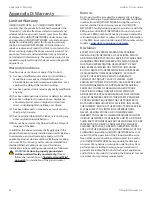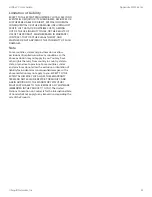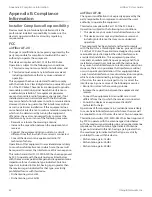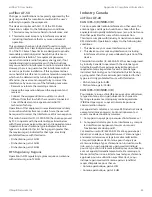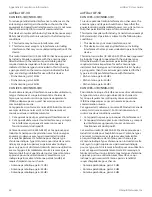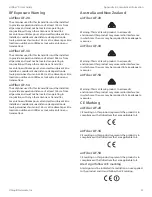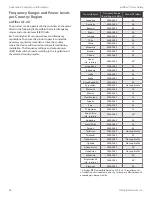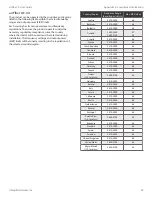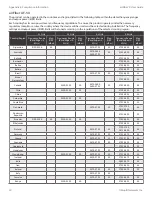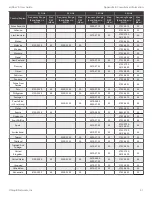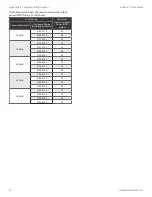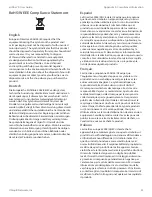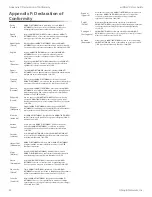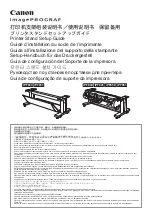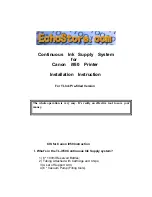
39
Appendix B: Listen Before Talk
airFiber
®
X User Guide
Ubiquiti Networks, Inc.
Appendix B: Listen Before Talk
Note:
This appendix applies to the airFiber AF-3X
radio only.
Introduction
Listen Before Talk (LBT) is a requirement for the 3.6 GHz
band in North America and Canada.
Because exclusive licenses for the 3650-3700 MHz band
are not granted within the United States, operators must
take steps to minimize potential interference in this band.
LBT refers to a contention-based protocol (CBP) that
requires a device to check if the transmission channel is in
use (listen) before it can initiate a transmission (talk). FCC
standards that relate to LBT include the following:
•
FCC Part 90, Subpart Z requires 3.6 GHz systems to
implement a contention-based protocol to provide
LBT capability. This same requirement has also been
adopted by Industry Canada (IC).
• FCC Part 90, Subpart Z defines two categories of
contention-based protocols,
restricted
and
unrestricted
:
-
Restricted contention-based protocol
This is a
protocol that can detect interference from products
that use a similar contention technology. Systems
using a restricted contention-based protocol operate
in the lower 25 MHz of the frequency band (3650-
3675 MHz).
-
Unrestricted contention-based protocol
This is a
protocol that can detect interference from products
that use a dissimilar contention technology. Systems
using an unrestricted contention-based protocol use
the full 50 MHz (3650-3700 MHz) of the frequency
band.
Unrestricted Protocol Description
The AF-3X Master/Slave system uses dedicated logic for
the LBT protocol, which is embedded into a TDD frame
structure. Energy detection is done at the beginning of
the TX defined by the frame structure of the air interface,
at intervals of 2.0, 2.5, 4.0, or 5.0 ms for compatibility
between various other Part 90Z radio devices.
Threshold Detection To Determine
Occupancy
The AF-3X averages the energy detected over a fixed listen
time and compares it to a preconfigured threshold value.
This threshold is configured for values that are within
the linear portion of the radio’s Receive Signal Strength
Indicator (RSSI) dynamic range.
The energy detection threshold is proportional to the
transmitter’s maximum transmit power. For example, if the
transmitter’s EIRP is 23 dBm, then the detection threshold
at the receiver’s input (assuming antenna gain of 0 dBi) is
-73 dBm/MHz.
The detection threshold is adjusted as follows:
DT = -73 dBm/MHz + 10log
10
(B) + 23 – P
T
+ A
where:
DT = Detection Threshold in dBm
B = Monitored bandwidth in MHz
P
T
= Maximum transmit power in dBm EIRP
A = Receive antenna gain in dBi
The receive antenna gain A is set equal to the external
antenna gain. The following are set by the operator during
the configuration of the AF-3X radio:
• maximum desired EIRP power P
T
• external antenna gain A
• channel bandwidth B
The AF-3X ensures that the sum of the actual conducted
power and the external antenna gain used to calculate P
T
does not exceed the regulatory EIRP limit.
The Master/Slave device makes an average measurement
during its Tx and samples the channel every frame
(typically 2.0 ms) to accumulate a co-channel signal
measurement. A typical accumulation period is 5 µs.
The bandwidth used for all channel occupancy
measurements is the same bandwidth used for system
operation and is configurable for values that range from
3.5 MHz to 40 MHz.
The detection threshold is configured to scale
automatically based on the in-use modulation level that
the system negotiates. The threshold level is automatically
set by the radio to meet regulatory requirements. All
threshold levels are normalized to a 0 dBi reference level.
The detection system uses the same hardware as the
actual radio lower-level software code and is therefore
operational over the same power range.
The AF-3X point-to-point system employs a proprietary
media access layer (MAC) that utilizes a TDD scheduled
transmission which is synchronized. Both the Master
and Slave employ a threshold detection mechanism
to monitor for other systems running within a selected
channel.
Action Taken When Occupancy is
Determined
Upon detection of occupancy, the Master will cease
transmission. It will continue to monitor the channel to
see if at any point that it becomes available.
Hidden-node problems are avoided by the AF-3X system’s
proprietary media access control (MAC) layer that utilizes
a TDD scheduled transmission (a synchronized framed
transmission). The Slave device cannot transmit until it
is allocated bandwidth from the Master device. If the
Master device detects co-channel signals, the uplink for
the scheduled slot allocation is not granted to the Slave,
preventing the Slave from transmitting. Since permission
to transmit is granted by the Master, there is no hidden
node problem like that experienced by Wi-Fi systems
which employ a contention-based protocol.


















